We may earn revenue from the products available on this page and participate in affiliate programs. Learn more ›
_
Best Overall

Wilson Combat SFX9
Best Value
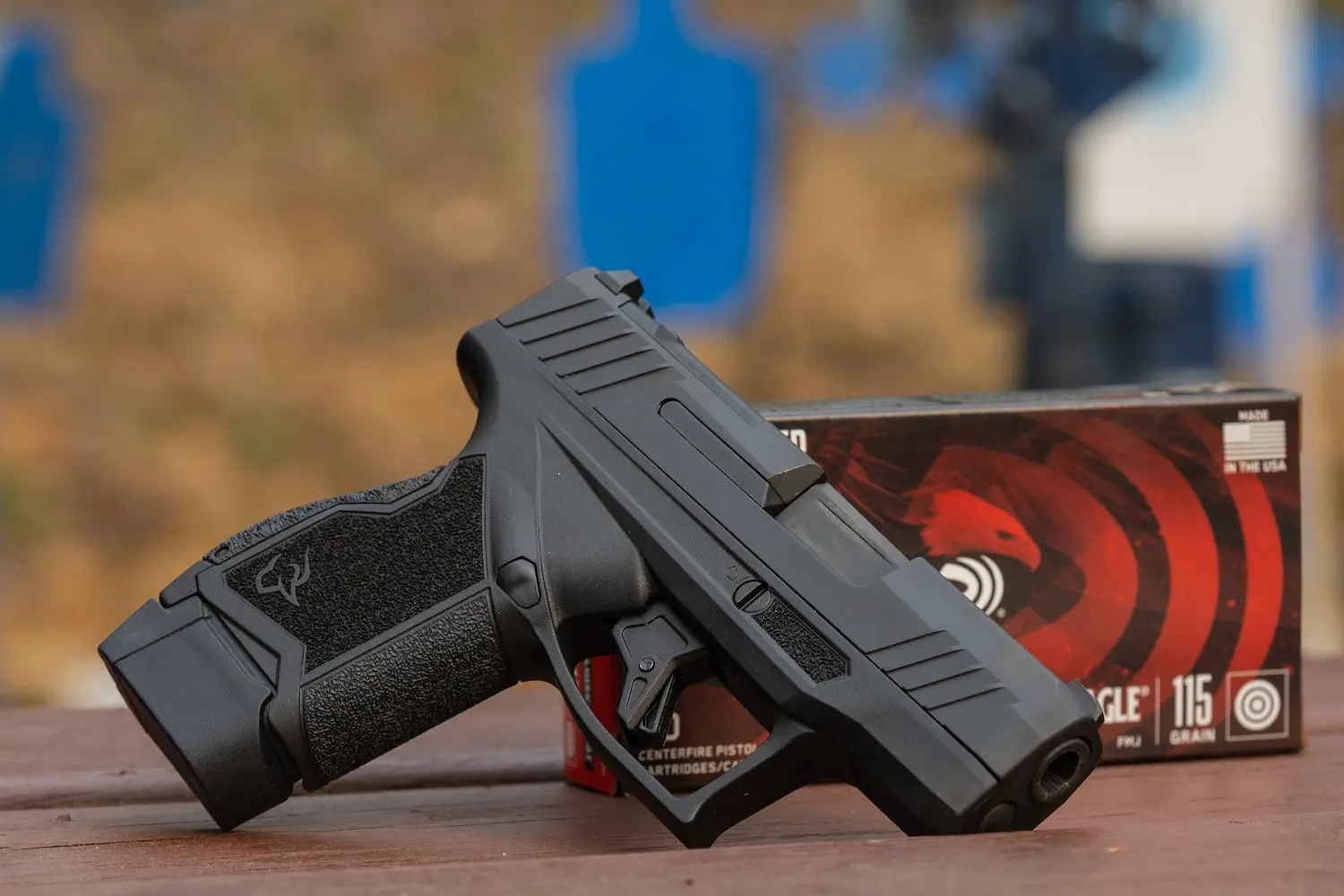
Taurus GX4
Best Revolver
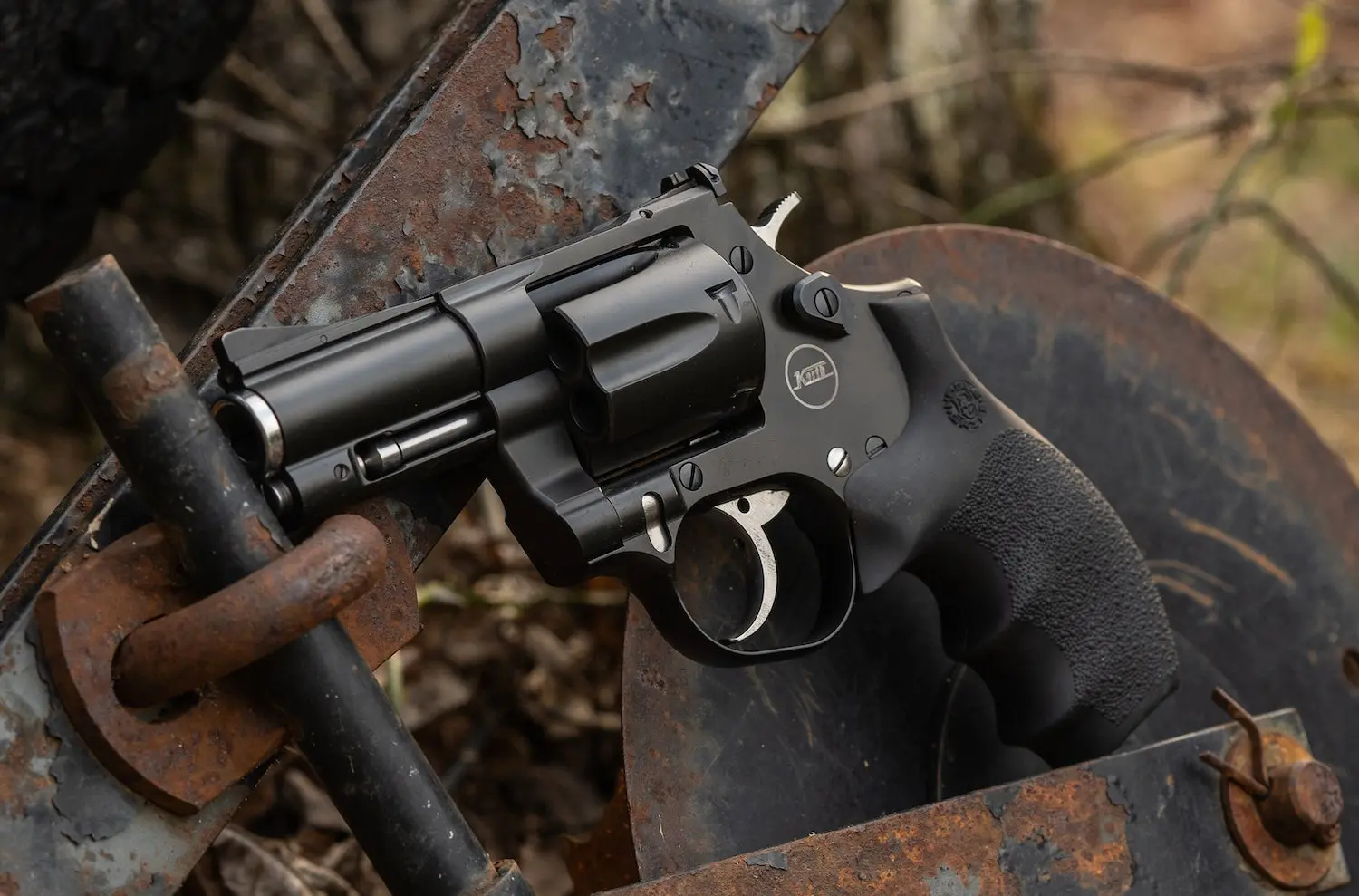
Korth 2.75-inch Carry Special
More people are buying handguns than ever before, making them the best-selling firearms in America right now. But guns cost money and with inflation, money is tight. If you’re one of the thousands of people looking for a new handgun, the last thing you want is to experience buyer’s remorse the first time you take it to the range. We’d like to help prevent that, and it’s why we conducted a test at my home and private range in West Virginia to evaluate as many of the year’s latest, most popular handguns as we could find.
I use the word “we,” because one shooter cannot provide a practical evaluation of how a group of handguns might appeal or interface with different people. So, to help with the test, I invited Field & Stream senior editor, Matthew Every; trained law enforcement SWAT officer Will McGuire; and graduate of Gunsite Academy’s 250 pistol course Sebastian Mann. This gave us a balanced opinion of experienced shooters, aged from 22 to 57 years. We also needed help with ammunition, targets, and holsters, and without Federal, Buffalo Bore, Thompson Targets, and Galco, our test of the best handguns would not have been possible.
Best Overall (Centerfire): Wilson Combat SFX9
Best Value (Centerfire): Taurus GX4
Best Revolver (Centerfire): Korth 2.75-inch Carry Special
Best for Outdoorsmen: Colt Python 3-inch
Best Overall (Rimfire): Taurus TX22 Competition SCR
Best Value (Rimfire): Heritage 6.5” Rough Rider Black Tactical Cowboy
Most Fun to Shoot: Sig Sauer P322
How We Tested the Best Handguns
Two of our shooters tested every new handgun for precision by shooting three, 5-shot groups from a sandbag rest at 10 yards, with at least two different loads. Then, working from holsters, we ran each gun through a series of timed defensive drills. The first was a 6-shot rendition of the El-Prez Drill without a reload. The goal in this drill was to get two hits each on three IPSC-size silhouette targets at 10 yards as fast as possible. This drill allowed us to evaluate how well we could transition between the targets with each handgun while getting fast hits along the way.
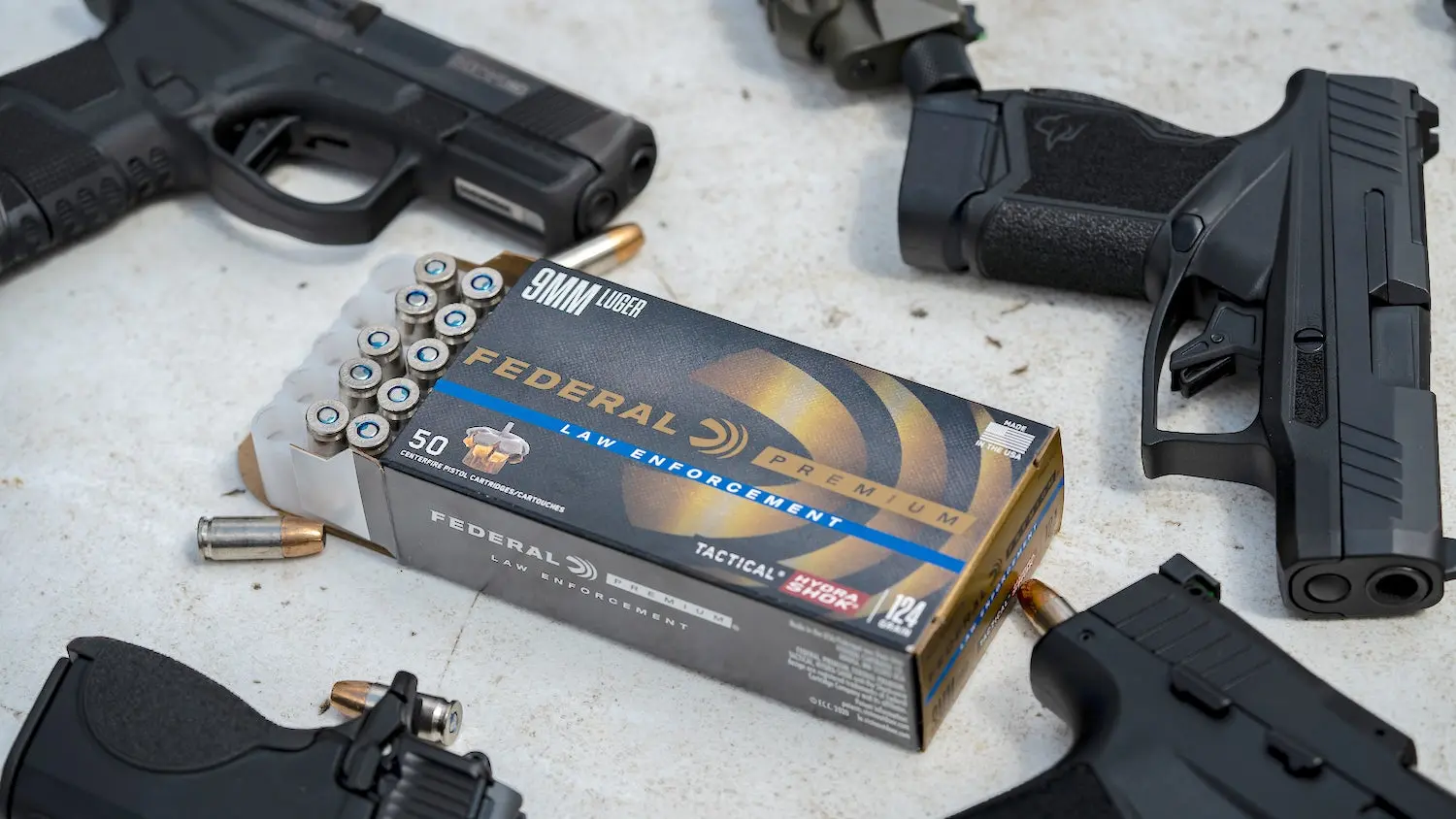
| Federal provided 9mm HST ammo and it was used to test every 9mm handgun. Sabastian Mann |
The second drill was a version of the Failure Drill. Normally, this drill requires double-tapping a torso target at five yards twice, evaluating the effects, and then firing a head shot if needed. We modified the drill to help us better evaluate our interface with each handgun while under pressure, and strived for a par time of 2 seconds. After drawing the gun, we hammered two quick shots to the torso and then—as fast as possible—made a precision shot on a swinging head-plate.
The third drill was my standard evaluation drill when evaluating defensive handguns. Called the Forty-Five Drill, it requires you to draw from the holster and fire five shots into a 5-inch circle at 5 yards in less than 5 seconds. This drill is a great measure of how hard the recoil of a handgun is to control. But at the same time, it requires a shooter to see the sights and deliver fast and accurate hits. It’s a drill where easy-shooting guns with good sights stand out.
How We Scored the Best Handguns
We fired a minimum of 200 rounds through each handgun. For those that we wanted to investigate further, that had a stoppage, or that we really enjoyed shooting, we fired two to three times that much. All the drills were scored, and we then awarded points in the following categories:
Precision/Accuracy (1-15 points)
Practical Drill Performance (1-15 points)
Suitability for Self-Defense/Carry (1-10 points)
Quality (1-10 points)
Shooting Comfort/Shooter Interface (1-10 points)
Holster Availability (1-5 points)
Reliability (30 points)
Value (1-5 points)
We added everything up for a possible total of 100.
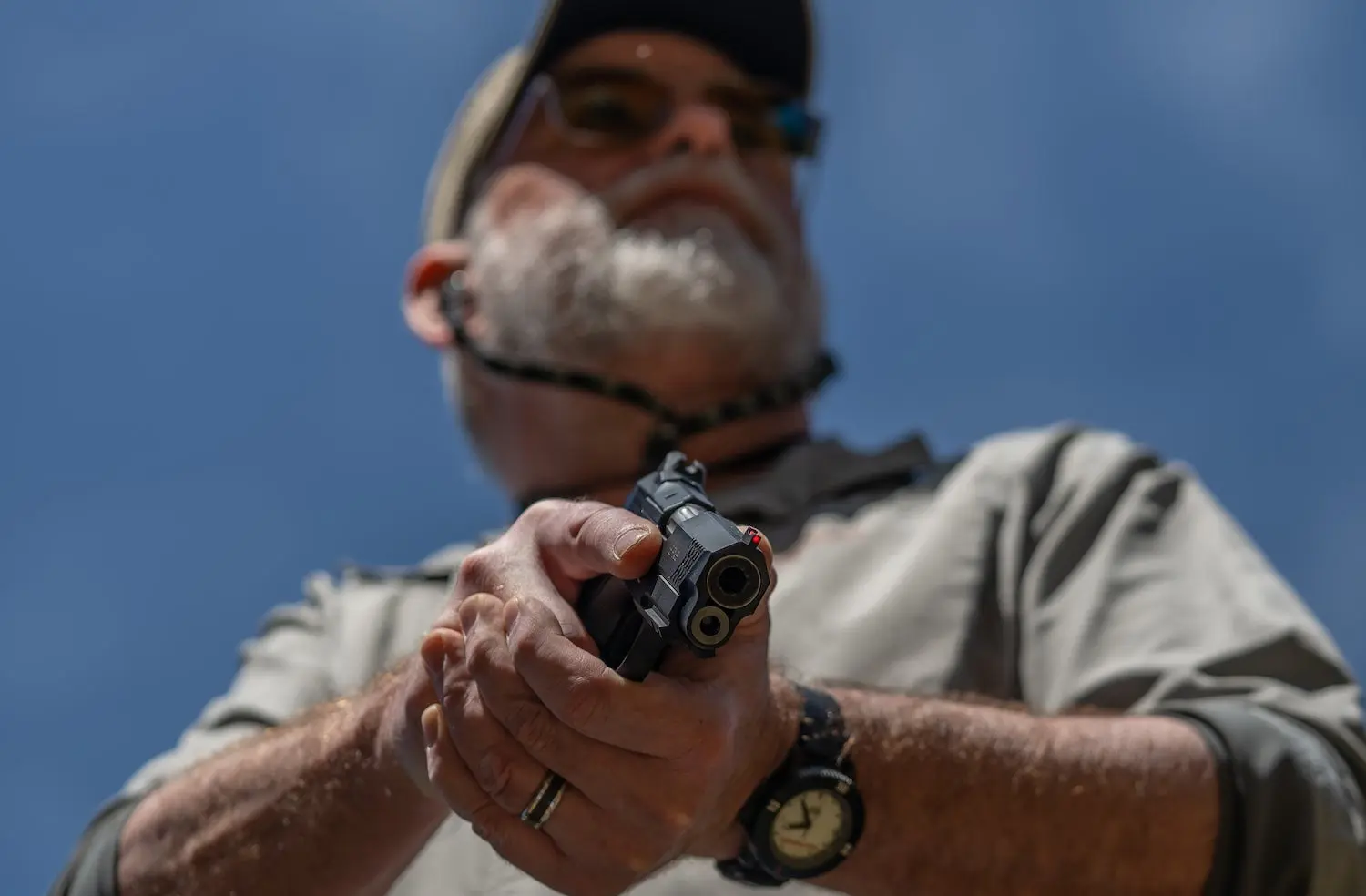
| Every handgun in our test was shot extensively by multiple shooters and with multiple loads. Sabastian Mann |
After all this, we discussed the results, argued opinions, and then named the Editors’ Pick for the best handgun of the year. We also recognized the handgun that offered the best value, and the revolver we thought was the best of the three tested. And, since this is Field & Stream, where you come to find the best information on hunting, fishing, camping, and survival, we selected what we felt was the best overall handgun for the outdoorsman.
Best Centerfire Handguns: Reviews & Recommendations
We saw three centerfire handgun trends this year. The first is the continuing popularity of ultra-compact 9mms. It seems like everyone wants one and that everyone is making one. Thirty-eight of the handguns we tested fit in this category. But somewhat surprisingly, there’s some nostalgia at play. Three of the 13 best handguns we tested were throwbacks to guns that were originally made in 1935 and 1955. And finally, firearms manufacturers and importers are taking advantage of the fine work and low labor costs found in Turkey and abroad. More than half of the handguns we tested were made or at least partially made outside of the United States.
Best Overall (Centerfire): Wilson Combat SFX9
(Score: 90.16)
Best Overall
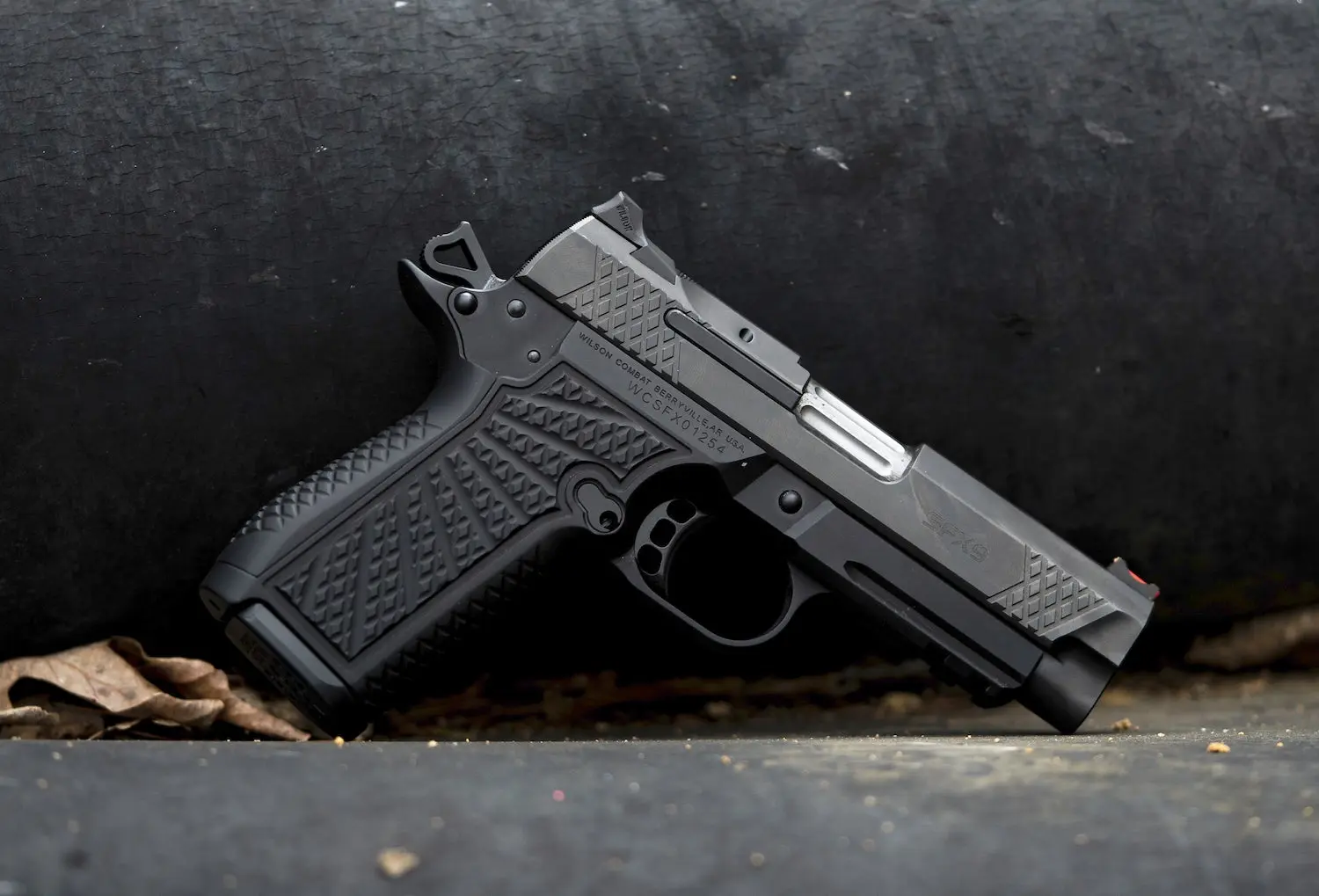
Specs
Price: $2,995
Chambering: 9mm Luger
Barrel length: 4 inches
Weight: 29.3 ounces (unloaded)
Trigger: 3.0 pounds
Capacity: 15+1
Pros
Quality of construction
User interface
Cons
Expensive
The SFX9 from Wilson Combat is essentially an upgraded version of their EDC X9 handgun. The difference is that the SFX9 has a solid frame. The flat-sided frame feels a bit Glockish, but the grip angle is pure 1911. And, like all 1911-style handguns, the SFX9 is a single-action semi-auto outfitted with a manual thumb safety. However, like the EDC X9, the SFX9 does not have a grip safety. The trigger on this pistol was superb, the sights were excellent for fast defensive work, and the action cycled with impeccable smoothness.
We shot this pistol a lot because we liked it. We did experience two failures to feed somewhere after about 450 rounds. That’s when we realized we’d not put a drop of gun oil on the handgun since the test began. After a little gun juice, we put another 200 rounds through the SFX9 without issue.
All involved considered the SFX9 as the most suitable pistol we tested for concealed carry and felt it had the best shooter interface. It also performed the best on all the defensive drills. In terms of construction quality, it tied with the Korth Revolver as the best of the bunch. This is not an inexpensive pistol—it lost almost 5 points because of its price—but once you get it in your hand and put it to the test, you realize why it costs what it does, making it the best handgun of the year.
Best Value (Centerfire): Taurus GX4
(Score: 88.25)

Specs
Price: $468
Chambering: 9mm Luger
Barrel length: 3.06 inches
Weight: 18.7 ounces
Trigger: 5.5 pounds
Capacity: 11+1
Pros
Price
Modular grip and optics ready
Cons
Field-strip requires a screwdriver
If you like the way a Glock looks and feels in your hand, you’ll like the Taurus GX4. It is a polymer-framed, striker-fired pistol, with a passive trigger safety, and a removable slide plate for optics mounting. At only 6 inches long and 4.4 inches high, it is an amazingly compact, and lightweight pistol. However, with its easy-to-see sights, it was very manageable on all the practical drills and scored fourth place overall in that category. Stacked up against all the other handguns in the test, this pistol ranked third, and had a best-of-the-test score of 4.64 points out of 5 on the value scale. We experienced no stoppages with the GX4.
The GX4 has a reversible magazine release and comes with two 11-round magazines with a much-appreciated extended base plate. An additional backstrap is supplied to help you adjust the grip to fit your hand. The slide stop is of minimal proportions to prevent accidental engagement, but is positioned well enough for thumb control if that’s how you like to release the slide. The rear sight is smartly devoid of unnecessary dots and the front sight has a white dot. The pistol disassembles easily enough, but a flat-blade screwdriver is required. This was the one feature our test group did not like.
Best Revolver: Korth 2.75-inch Carry Special
(Score: 85.04)

Specs
Price: $3,699
Chambering: 38 Special, 357 Magnum, 9mm Luger
Barrel length: 2.75-inch
Weight: 33.6
Trigger: 7.75 lbs. (double-action) 3.0 lbs. (single-action)
Capacity: 6
Pros
Incredible trigger
Multi-cartridge compatibility
Cons
Price
Upfront it must be acknowledged that this is a very good handgun. It tied for quality of construction with the Wilson Combat SFX9, but because it’s a revolver, and because it’s put together so well, it just seemed sort of special. With the single exception of a plain black—hard-to-see—front sight, no one that handled the Korth said it could have been made better. Regarding the sight, the handgun we tested was an early version. All new Carry Specials come with a gold bead front sight. Up against semi-auto pistols, it ranked 9th overall. Had it had the easier to see front sight it would have probably come in several spots higher.
Aside from having the best double and single-action trigger of any revolver anyone in the test group had ever pulled, in a matter of seconds, you can swap the cylinder and convert this gun to fire 9mm Luger. (We tested 9mm Luger, .38 Special, and .357 Magnum loads in the Korth.) Of course, the downside is the price. You could purchase eight Taurus GX4s for the same money. On the other hand, a 6-shot revolver will handle most defensive handgun situations, and there’s some comfort in knowing you’re carrying what might be the best revolver ever made. Its ammo interchangeability, combined with the level of precision the Korth delivered, makes this pistol quite versatile.
Best for Outdoorsmen: Colt Python 3-inch
(Score: 84.42)
Best for Outdoorsmen

Specs
Price: $1,499
Chambering: 38 Special/357 Magnum
Barrel length: 3 inches
Weight: 38 ounces
Trigger: 8.5 lbs (double-action) 5.0 lbs (single-action)
Capacity: 6
Pros
Fit and finish
Cool factor and style
Cons
It only comes in stainless
Heavy
For 50 years, many considered the Colt Python the Cadillac of revolvers. It was one of the most popular handguns, made famous by the 1973 film, Electra Glide in Blue, and its prices doubled after it was discontinued in 2005. Now reintroduced by Colt, they offer a 6-, 4.25-, and 3-inch version, the last of which is the latest. Our test gun had an impeccable polished stainless finish, nice wood grips, an adjustable rear sight, and an interchangeable front sight. Though a tad large for everyday carry, based on the price and quality, we felt it the best handgun for outdoorsmen who might use it for hunting, trail carry, or just about anything else someone who lives outside might need to do with a handgun.
On the practical drills, the Python outperformed all the revolvers in the test. It received a score of 9 out of 10 in quality of construction and shooter comfort. With light .38 Special loads, it’s ideal for plinking, with quality hollow points it will work for personal protection; and with Buffalo Bore .357 Magnum hardcast loads, it’s suitable for hunting or bear protection. The Python was the heaviest of all the guns tested but there are plenty of good holsters to choose from. Though it was the third most expensive gun we examined, it was without question the most beautiful. And you could buy two Pythons and a lot of ammunition for the price of the Korth.
Kimber R7 Mako
(Score: 89.43)
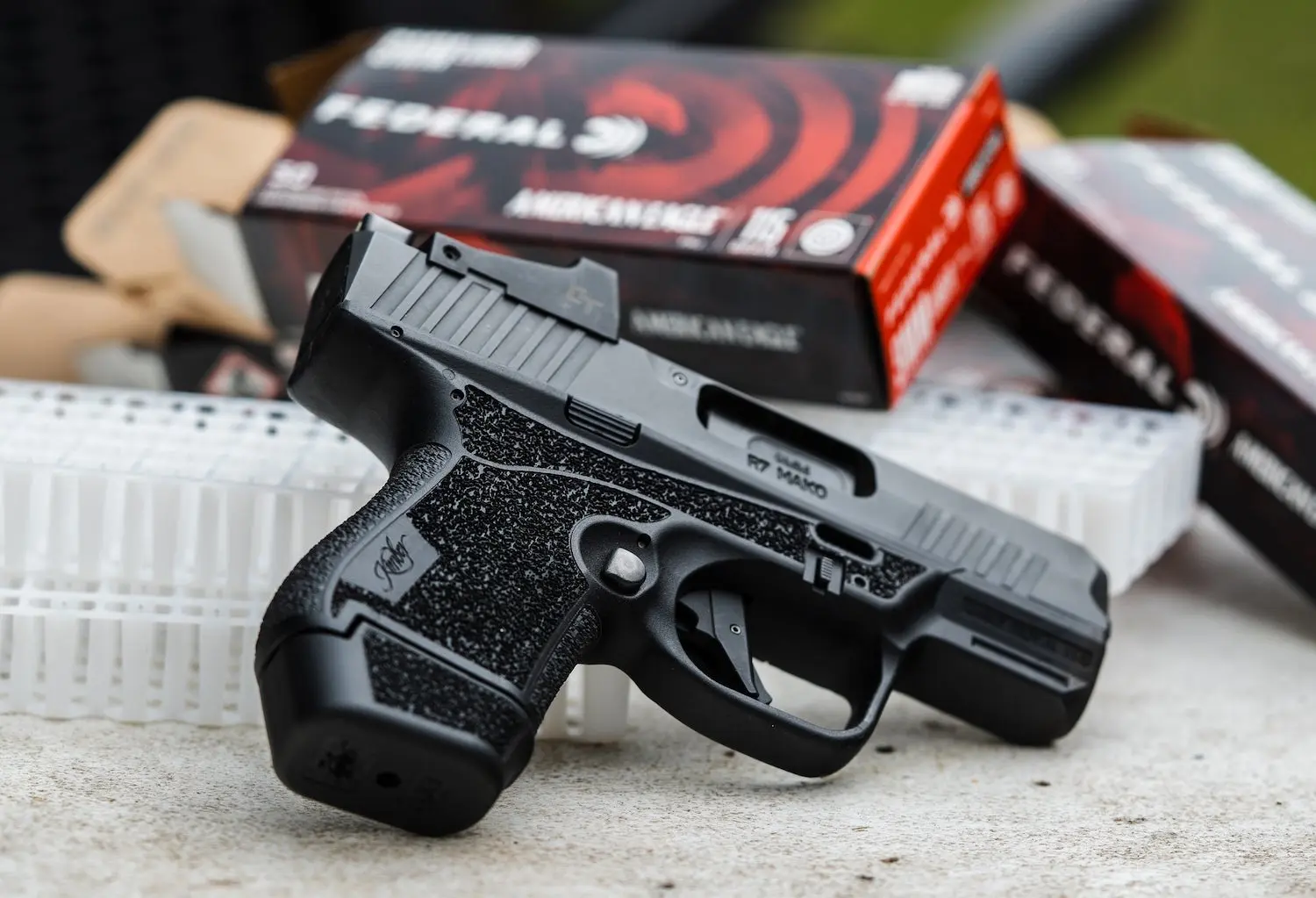
Specs
Price: $799
Barrel length: 3.37 inches
Weight: 19.5 ounces (20.5 ounces with Crimson Trace sight)
Trigger: 5.5 pounds
Capacity: 10+1 (as tested) 11+1 and 13+1 as advertised.
Pros
Available with reflex sight from the factory
Decent Trigger
Cons
Ugly
The Mako functioned flawlessly and delivered the second-best score on precision from the bench. It also received the second-highest score for suitability for concealed carry. We tested the Optics-Installed version which comes with a Crimson Trace CTS-1500 reflex sight and costs $200 more than the standard version, which is also optics ready. Both are fitted with three-dot Tritium sights. The pistol is advertised as coming with an 11-round and a 13-round extended magazine. Ours came with two 10-round magazines, one of which was extended—making the pistol much more comfortable in hand. The trigger pull on our test gun was good for a striker-fired handgun, and it had a very distinct and audible reset.
The Mako’s slide lock is well protected from accidental engagement and easy to reach with the thumb of the shooting hand. The slide lock is also ambidextrous, as is the Mako’s magazine release. Texturing on the full circumference of the grip was about ideal for comfort and retention, and the Mako is very easy to field strip. Most of the testers thought the pistol a bit ugly but that did not negatively impact its performance. However, there is a safety recall on the Mako—our test gun had been serviced. Supposedly this addressed a safety issue with the firing pin block but did nothing to help the pistol’s looks.
Tisas PX9 Gen III Tactical
(88.01)
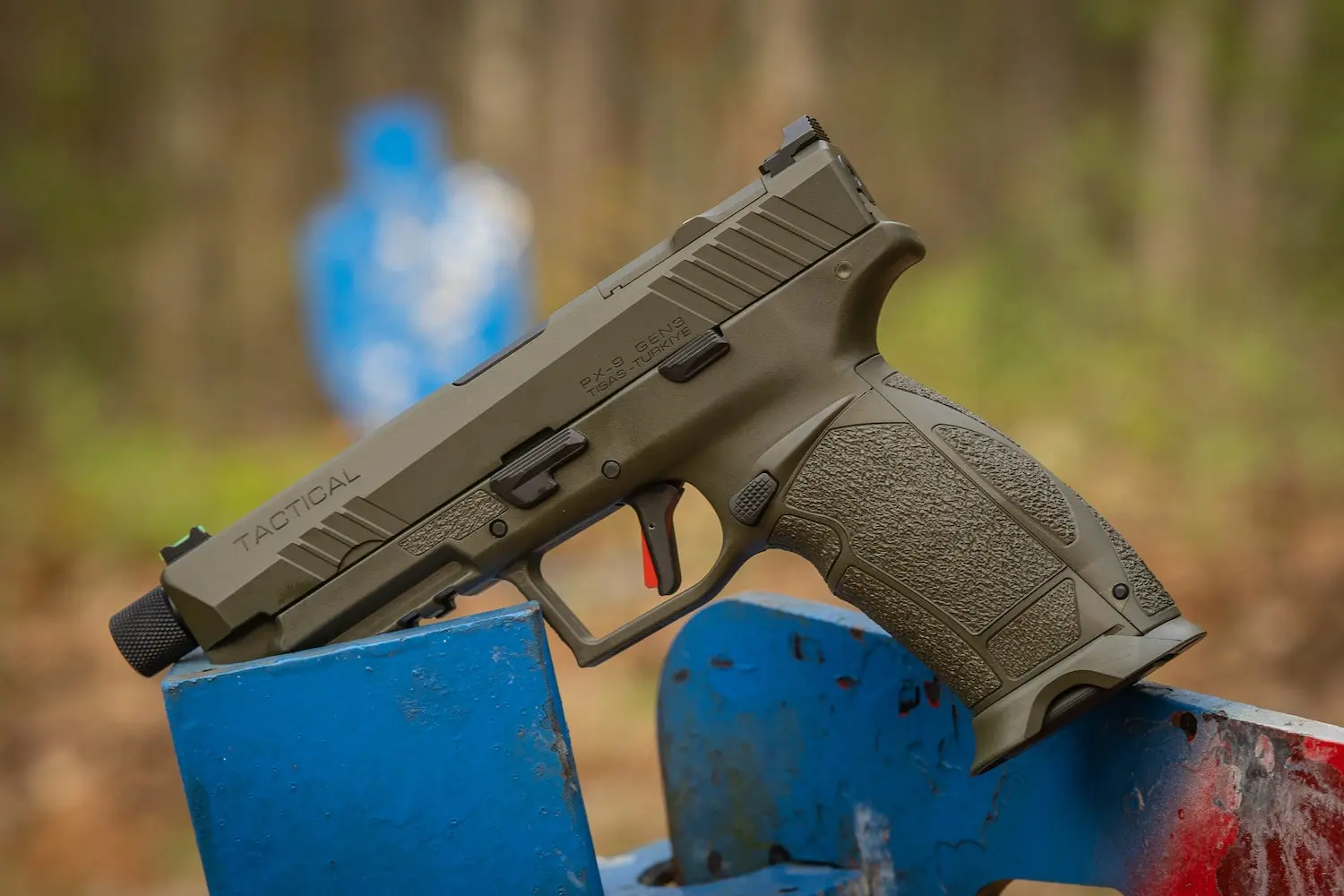
Specs
Price: $579.95
Chambering: 9mm Luger
Barrel length: 4.0 inches
Weight: 26.8 ounces
Trigger: 4.0 pounds
Capacity: 18+1
Pros
Price
Extremely modular grip
Optics-ready
Cons
A bit large for concealed carry
What should you expect from a striker-fired, Turkish-made, polymer pistol, that you can pick up for around $500? Based on our testing, a lot. This pistol delivered the best precision from the bench, performed second-best on the defensive drills, and was rated second with regard to shooter interface/shooting comfort. The PX9 is also loaded with features. It’s optics-ready, has an 18+1 capacity, optional flared magazine well, interchangeable grip panels and backstrap, a threaded muzzle, and a fixed rear and fiber optic front sight. It’s also available in black, flat dark earth, or olive, and the slide has a Cerakote finish.
So, with all this going for it, why did it not come out as the best of our test? This is a duty-size pistol; it’s a bit large for concealed carry. It was also supplied with a poorly designed IWB holster. (The PX9 will fit Springfield XD holsters.) The trigger broke at four pounds but had the typical mush of many striker-fired handguns, and out of the 300 plus rounds fired, we had one failure to feed. Still, of the 13 handguns tested, it ranked fourth in value and, though it is a bit big, would make an ideal home defense handgun—especially with its accessory rail for a weapon light. Don’t overlook this gun because of its Turkish construction. It’s a fine pistol.
Mossberg MC2sc
(Score: 87.80)
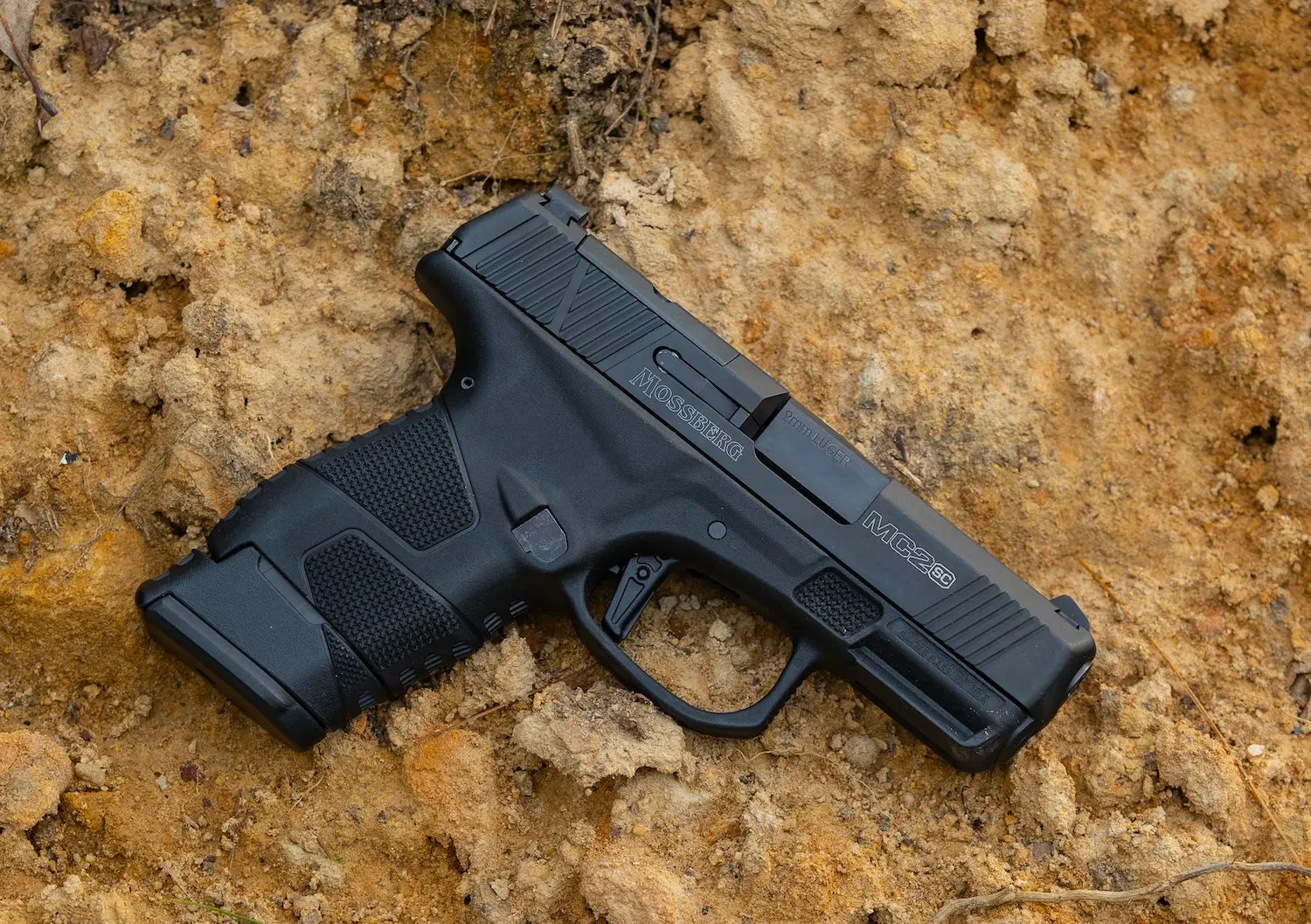
Specs
Price: $556.00
Barrel length: 3.4 inches
Weight: 19.5 ounces
Trigger: 5.5 pounds
Capacity: 11+1 or 14+1
Pros
Easy and safe disassembly
Optics-ready
Cons
Trigger finger pinch
Fed from a double-stack magazine, the MC2sc replaced Mossberg’s MC1sc single-stack magazine-fed, micro 9mm pistol. Surprisingly, the grip on this higher-capacity pistol is only infinitesimally thicker. The pistol ships with an 11- and a 14-round magazine, and is available with white three-dot sights or TruGlo Tritium sights. One version even comes with a cross-bolt safety, and all versions have an optics-ready slide cut.
The MC2sc was a close second to the Taurus GX4 for the best value award. The Taurus beat it by less than a half-point, which was earned solely by the Taurus’s $88-less suggested retail price. But the Mossberg delivered slightly better precision from the bench, performed slightly better in the practical drills, and is much easier to field strip.
Some shooters did experience a bit of finger pinch between the tip of the trigger and the trigger guard, which did detract from its shooting comfort score. However, the MC2sc was ultra-reliable. One of the things that sets the MC2sc apart from the other Micro 9mm pistols is how safe and easy it is to field strip. You simply lock the slide to the rear, remove the striker plate on the back of the slide, and then pull out the striker. When you release the slide, it comes completely off the pistol, with no need to pull the trigger.
Springfield SA-35
(Score: 85.68)
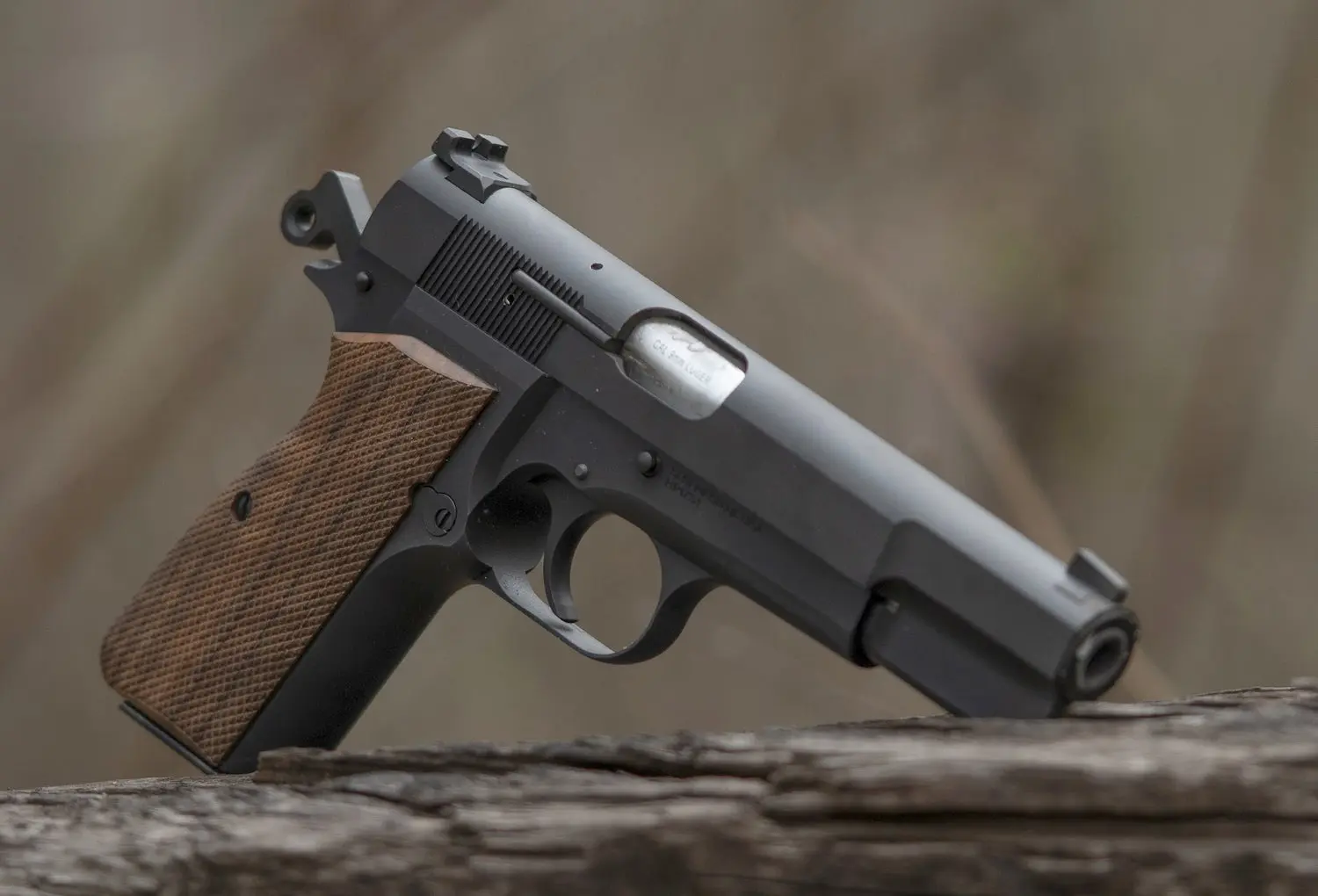
Specs
Price: $699
Chambering: 9mm Luger
Barrel length: 4.62 inches
Weight: 29.6 ounces
Trigger: 5.0 pounds
Capacity: 15+1
Pros
Elegant and classy appearance
Soft shooting
Cons
Hammer bite
Non-ambidextrous safety
Springfield Armory’s SA-35 is a mostly faithful clone of what is maybe the most prevalent fighting pistol ever made. The primary difference in the SA-35 and now-discontinued Browning HiPower, is that the SA-35 does not have a magazine disconnect safety. It does have a Commander-style hammer, a slightly chamfered mag well, and very good sights. The SA-35 is a very attractive pistol and ranked third in quality of construction in our test. During the first 30 rounds, we did experience a single stove-pipe—failure to fully eject—stoppage. After some lube, it digested the next 200-plus rounds flawlessly. It costs a bit more than the EAA MC P35, and while we’re not sure it’s made any better, it does have an air of sophistication the MC P35 lacks.
Even at five pounds, the trigger on our test gun was nice. Though some reviews claim Springfield fixed the irritating hammer-bite of the HiPower, all our test shooters experienced it. By outsourcing a partially completed frame and slide, Springfield was able to keep costs down on the SA-35 and still meet the “made in America” requirement—it costs about half of a used Browning HiPower in good condition. One of our testers who had never shot a HiPower had trouble with his support thumb engaging the slide lock. This is something to consider but is correctable with training and practice. Springfield-Armory’s SA-35 is a wonderful example of a classic pistol.
EAA MC P35
(Score: 85.64)
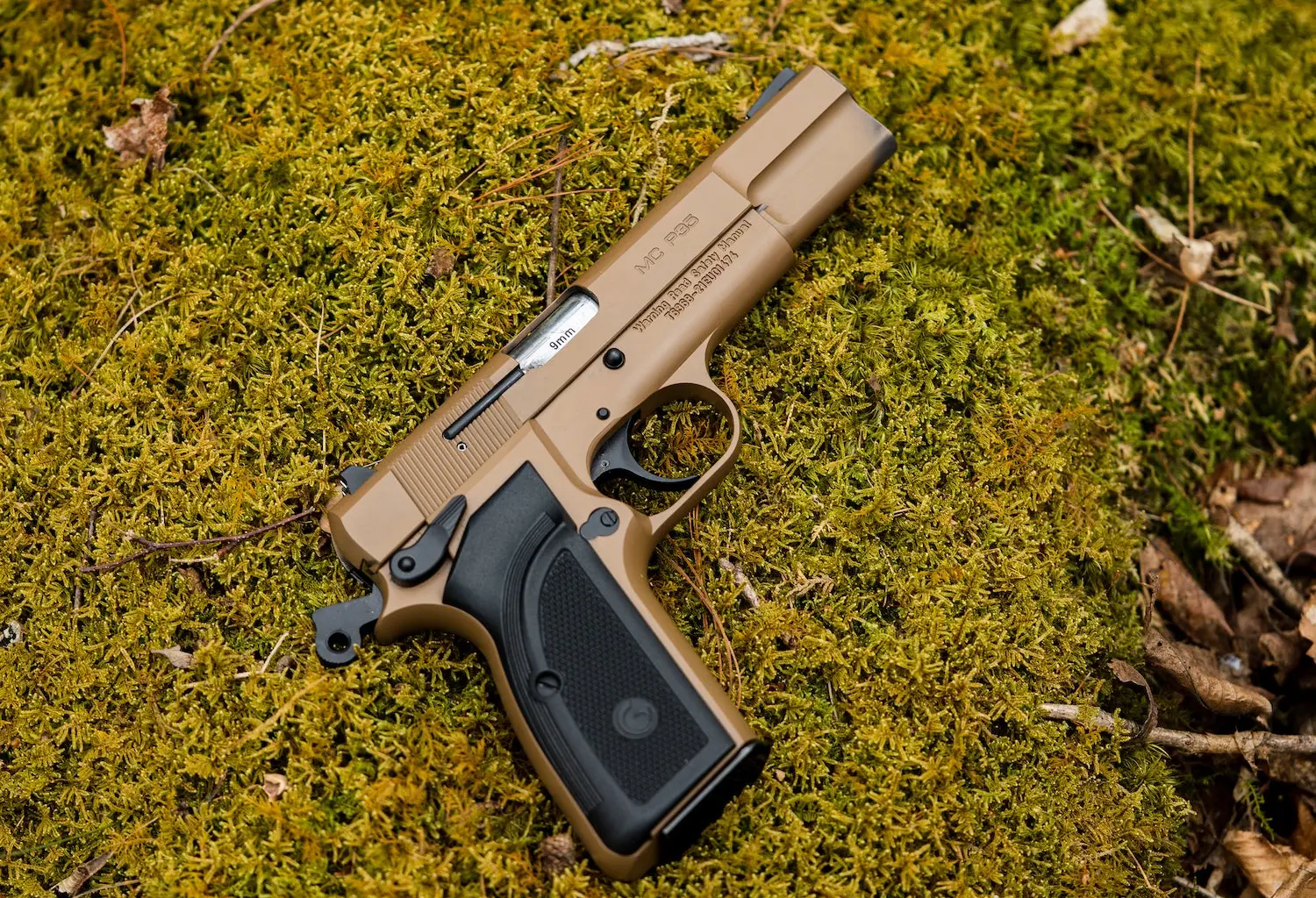
Specs
Price: $567
Chambering: 9mm Luger
Barrel length: 4.62
Weight: 29.8 ounces
Trigger: 5.5 pounds
Capacity: 15+1
Pros
Price
Soft shooting
Cons
Hammer bite
Magazine-disconnect safety
The HiPower is one of the most iconic handguns of all time, and its pivoting trigger, double-stack magazine, and link-less barrel are the foundation for almost every modern semi-automatic handgun. By modern standards, it’s a bit large and heavy for concealed carry, though I carry an original lightweight HiPower almost every day. EAA’s MC P35 is a close copy of the Browning HiPower and includes the magazine disconnect safety—the pistol will not fire without a magazine inserted. Owners often disable this feature to improve the trigger pull. Also, because of the magazine disconnect, the magazines will not drop free. The MC P35’s trigger had some gritty take-up but broke cleanly, and all shooters experienced some hammer bite, which is common with the HiPower.
During our bench rest precision testing, the Springfield SA-35 performed slightly better, but in the practical drills, the MC P35 and SA-35 performed identically. Since they’re essentially the same pistol, you would expect this, and it somewhat validated our testing protocol. The MC P35 had sufficient sights and the ramped front sight is very holster friendly. It also has an ambidextrous thumb safety. The pistol is manufactured in Turkey by Girsan, and all the shooters were impressed by its quality. However, the black plastic grips and desert tan Cerakote finish—it’s also available in blue/black, and two-tone black and grey—gave the gun a somewhat toyish appearance. The pistol proved to be 100 percent reliable.
Smith & Wesson CSX
(Score: 85.48)
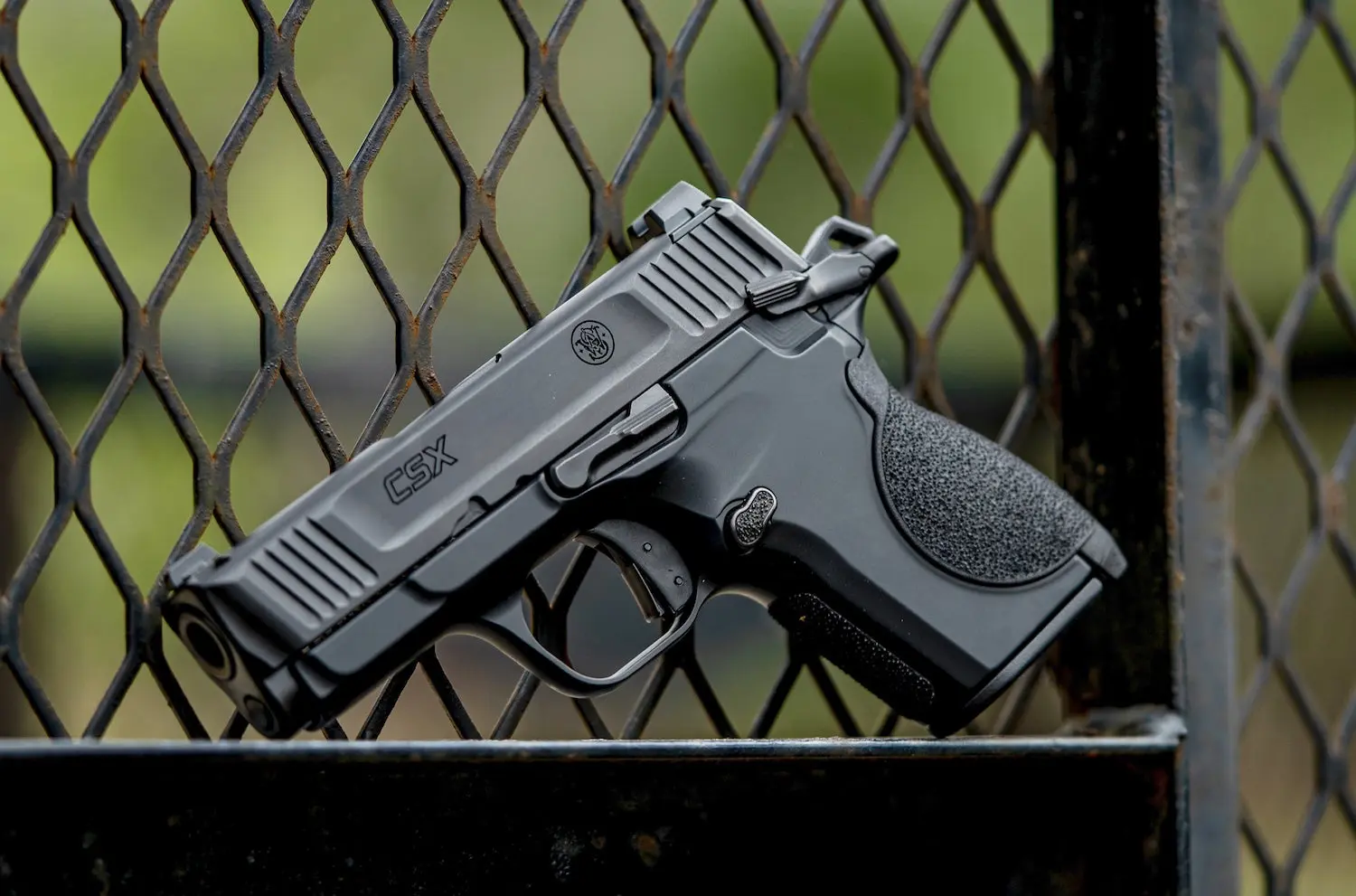
Specs
Price: $609
Barrel length: 3.1 inches
Weight: 19.5 ounces
Trigger: 5.0 pounds
Capacity: 10+1 and 12+1
Pros
Compact and concealable
Manual thumb safety
Cons
Poor trigger
Problematic disassembly
For a single-action trigger, the one on our CSX test pistol was bad. It had some mush and take-up. This was very noticeable from the bench but not so much when shot under pressure during the practical drills. During the precision bench rest testing, the CSX only outperformed two of the 13 handguns tested. However, and very surprisingly, during the practical drills, it scored third.
At only 6.1 inches long, the CSX is a very compact pistol, but it weighs in at 19.5 ounces even with its alloy frame. The pistol ships with a 10- and a 12-round magazine, the slide lock and manual thumb safety are ambidextrous, and it also ships with an extra backstrap to allow for some adjustment to the grip.
We found field stripping the pistol a bit tedious and a drift punch is required to complete the operation. The manual thumb safety could have been a bit larger, which would have made it easier to operate, and oddly, this single-action pistol also has the Glock-like passive safety on its pivoting trigger. The backstrap was easy enough to swap out and a tool for this was even supplied with the pistol. It would have been nice to have a punch supplied as well to help with field stripping. The CSX was utterly reliable and should make a good everyday-carry gun. With a few tweaks, it would be very nice.
Springfield Armory XD Elite 3.8 OSP
(Score: 80.57)
Springfield Armory XD Elite 3.8 OSP
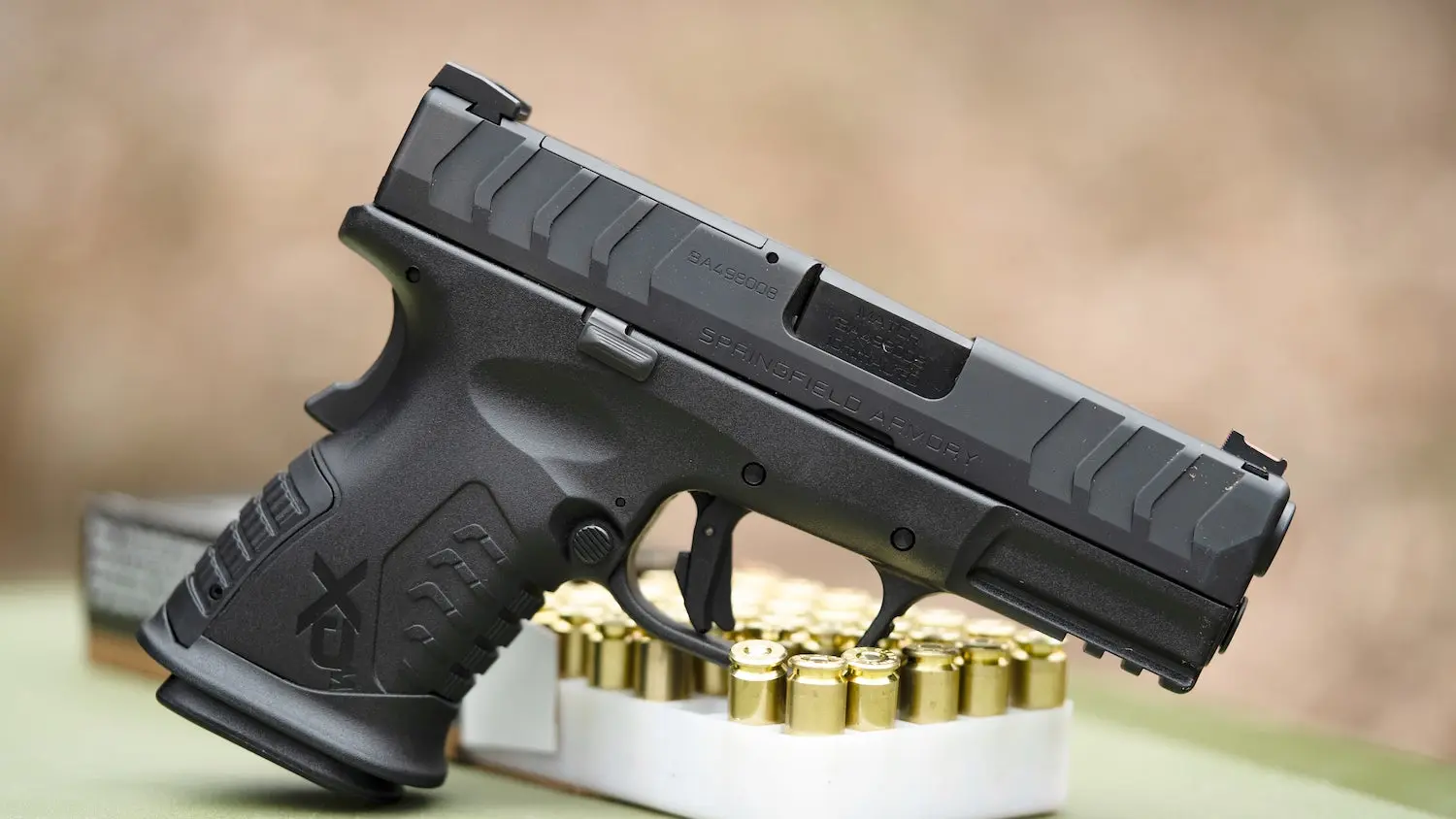
Specs
Price: $653
Chambering: 10mm
Barrel length: 3.8 inches
Weight: 27 ounces
Trigger: 4.5 pounds
Capacity: 11+1
Pros
Power
Capacity to size
Cons
Harsh recoil
Smallish/uncomfortable grip
Our test group was a bit confused about the Springfield Armory XD Elite 3.8 OSP. It tips the scales at only 27 ounces, which is light for a 10mm. The barrel was also only 3.8-inches long, which is short for this cartridge. However, if a compact 11+1 capacity 10mm is what you’re looking for, this is your gun. The question we had was, what would anyone want with a micro-compact 10mm? Recoil was not pleasant, and the flared bottom of the grip did not fit anyone’s hand comfortably. After the 42-round practical drill session fired by each shooter, we all massaged our hands and questioned the concept.
Disregarding the practicality of this pistol, it proved to be very precise from the bench, ranking third in our test for accuracy. Being optics ready, it would have probably performed even better with a mini-reflex sight installed. (For an additional $184 it comes from the factory with a Hex Dragonfly reflex sight.) If you wanted the smallest semi-auto available for defense against big bears, it would also make sense. But that application doesn’t call for a compact and concealable firearm. Oddly enough, Springfield-Armory once offered longer barreled 10mm XD handguns, but all have been discontinued. If, however, you must have a 10mm, and it must be small, look no further.
Taurus Model 605
(Score: 80.53)
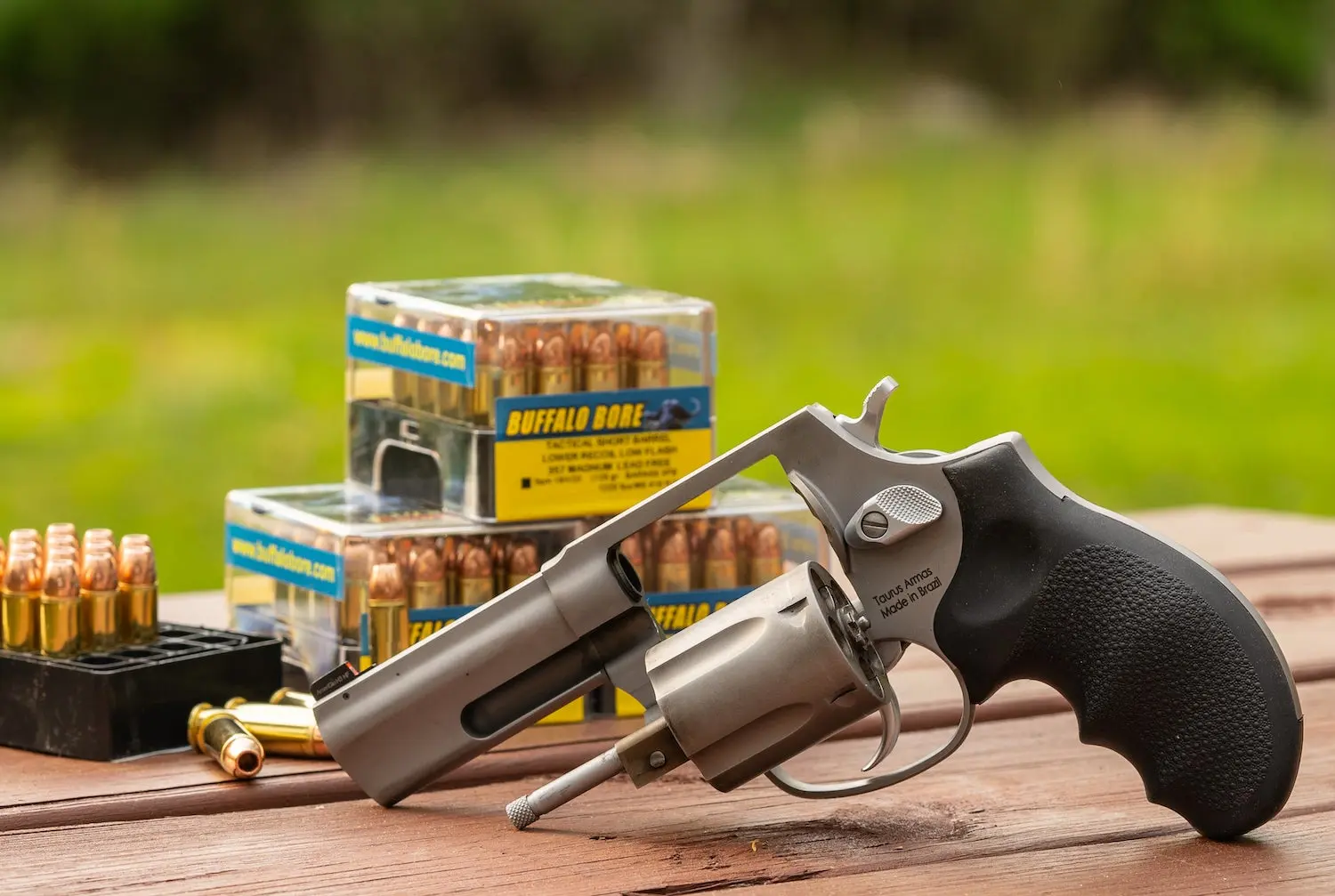
Specs
Price: $472.63
Chambering: 38 Special/357 Magnum
Barrel length: 3.0 inches
Weight: 23.52 ounces
Trigger: 5.25 pounds (single action) 10+ pounds (double action)
Capacity: 5
Pros
Compact for concealed carry
Affordable
Cons
Robust recoil
Poor trigger
This Brazilian-made revolver ranked as the second-best value in the test. From the bench, it performed just as well as the Colt Python. However, this is a five-shot as opposed to a six-shot revolver, and it’s limited capacity hurt it during the practical drills. However, it was the lightest and easiest to conceal of the three revolvers we examined. Of course, along with that came increased recoil.
One feature we really liked was the orange-outlined Tritium front sight that stood out like a beacon on the target. On the other hand, the trigger pull fooled a couple of the shooters who short-stroked it during speed drills. In the double-action mode, you must pull this trigger like you mean it.
The little 605 did have a comfortable and sculptured Hogue rubber grip and we found the brushed stainless-steel finish attractive. With standard-pressure .38 Special loads, it was comfortable, and with +P .38 Special loads, it was not overly offensive. However, with full-power .357 Magnum loads, it was a handful. Given its size, it did outrank seven of the 13 guns tested with regard to suitability for concealed carry. The single-action trigger pull was a bit stiff and the double-action pull was too heavy for our 10-pound gauge to measure.
Savage Stance
(Score: 76.62)
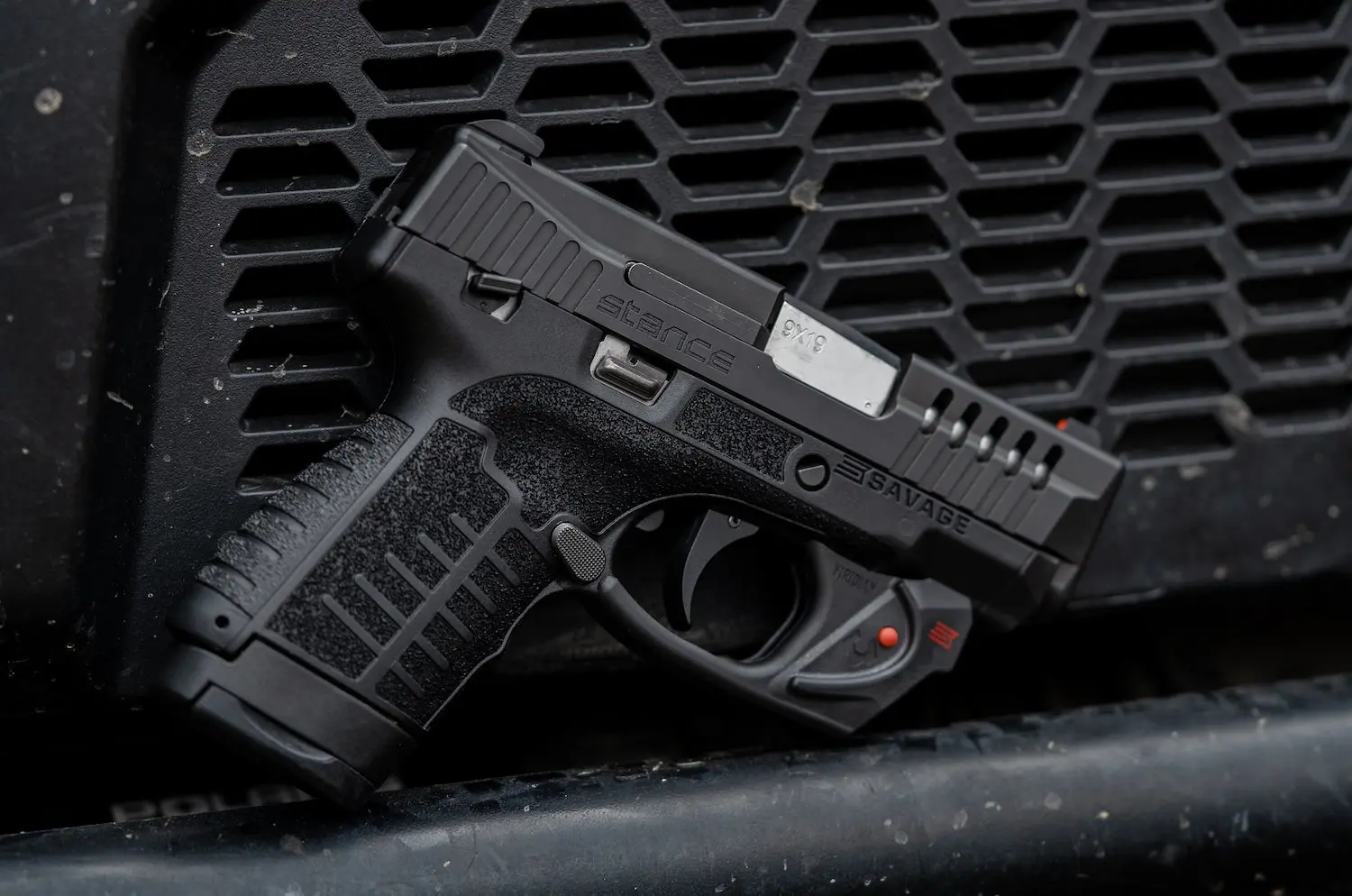
Specs
Price: $561
Barrel length: 3.2 inches
Weight: 20.8 ounces
Trigger: 7 pounds
Capacity: 7+1 or 8+1
Pros
Comfortable grip
Good combat sights
Cons
Safety is small and hard to manipulate
Sights are not zeroed from the factory
The Stance did not perform well in any of our tests other than reliability. We tested the $561 version with the Viridian laser. The slim grip, which houses the single-stack 7- or 8-round magazines that come with the pistol, is reasonably comfortable. However, the pistol has a distinct top-heavy feel. It got good marks for the nice U-notch rear sight and factory-installed laser, but neither the laser nor the fixed sights were zeroed from the factory.
The Stance does come with an easy-to-swap-out backstrap, but the ambidextrous manual thumb safety was just not large enough for easy operation during fast-draw and when manipulated under the stress of the clock. Also, weighing in at 20.8 ounces, it was one of the heaviest micro 9mms we tested. The slide required substantial force to operate when compared to the other pistols.
On the plus side, the pistol functioned flawlessly with every load we tried in it. Field stripping the pistol is easy and rotating the takedown lever deactivates the sear, which is an added safety feature. The Stance could save your life, but even at the laser-less price of $479, the Taurus is a better option.
Best Rimfire Handguns: Reviews & Recommendations
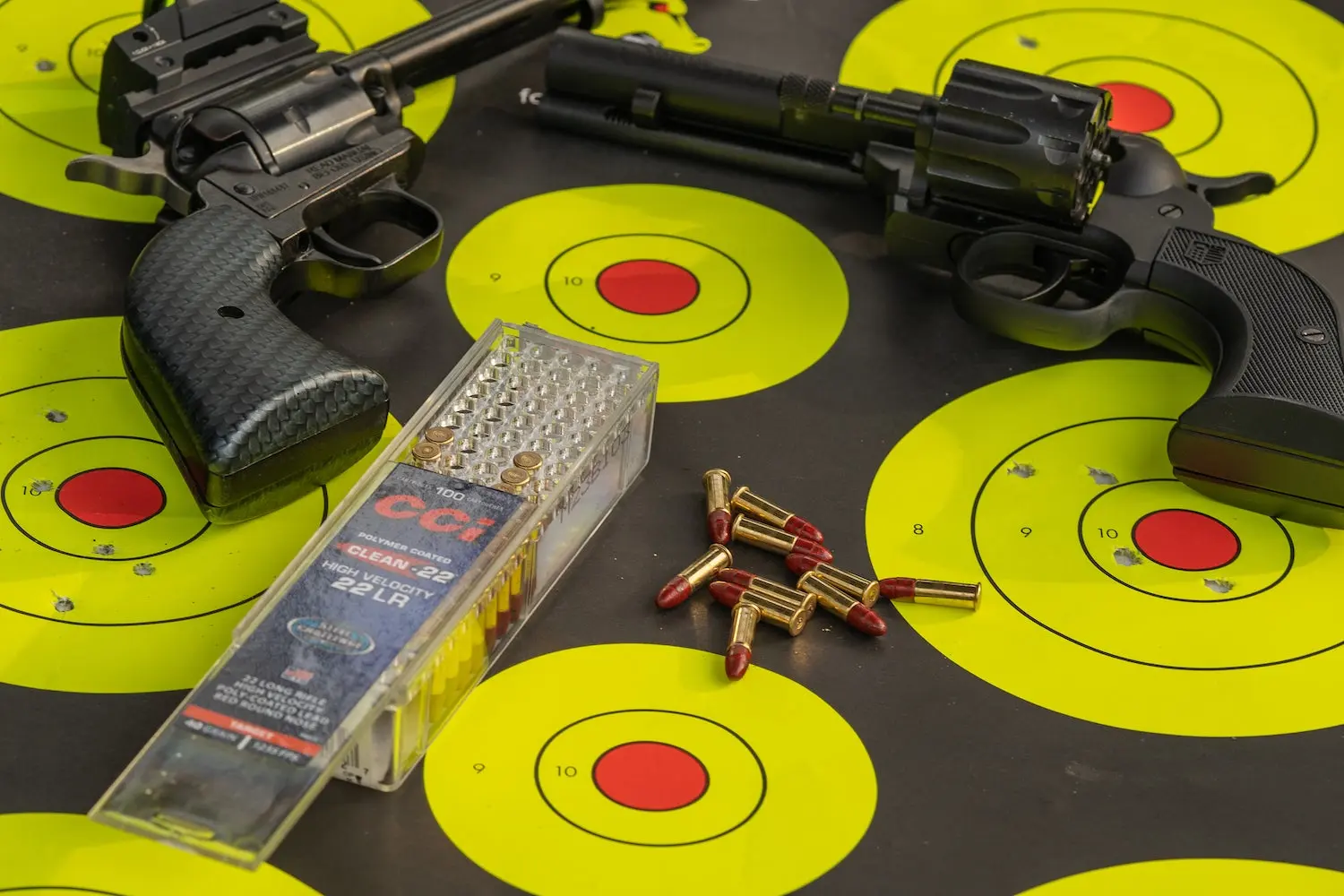
| The rimfire handguns were put through a variety of drills at different distances using Thompson Targets. Sabastian Mann |
No other gun is as fun to shoot as a .22 pistol. Ammo is inexpensive, recoil is negligible, they’re not excessively loud, and they’re guns that can be managed by young and old shooters. Fortunately, this year we saw the introduction of several new .22 pistols, and we wanted to know which ones were the best. So, we assembled all the new .22 handguns we could find, secured a bunch of targets from Thompson Targets, and a pile of ammo from CCI and Federal.
How We Test Rimfire Handguns
Testing a diverse mix of .22 handguns is complicated because they’re used for such a wide variety of things. We had to balance our evaluation to consider things like plinking, hunting, training, and trail carry. And the features that allow a handgun to perform well in one category may not be optimal in another.
First, we tested each handgun for accuracy by firing three, 5-shot groups at 10 yards from a sandbag rest with at least two different loads. Then we subjected the guns to a variety of drills. We shot at squirrel targets at 15 yards, shot at bullseye targets from 15 to 25 yards, and we conducted some timed plinking drills. All test participants ran roughly 200 rounds through each handgun. We all shot the drills and averaged the scores. But we didn’t stop there.
How We Score Rimfire Handguns
After all that shooting, we evaluated each handgun on its suitability for hunting, plinking, and training, its quality of construction, and on how comfortable it was to shoot. With the raw scores in hand, we made deductions for stoppages, then adjusted the total score based on the suggested retail price. We settled any debates between the evaluators with more shooting and even some friendly competitions. In the end, all the drills were scored, and we then awarded points in the following categories:
Precision/Accuracy (1-15 points)
Practical Application Shooting (1-15 points)
Suitability for Hunting, Plinking, Training, and Trail Carry (1-10 points)
Quality (1-10 points)
Shooting Comfort/Shooter Interface (1-10 points)
Holster Availability (1-5 points)
Reliability (30 points)
Value (1-5 points)
We added everything up for a possible total of 100 points. Then we selected our winners: The Editors’ Rimfire Pick, the Best Rimfire Value, and the handgun that we thought was the most fun to shoot. Here are our picks for the best handguns of 2024 in the rimfire category.
Best Overall (Rimfire): Taurus TX22 Competition SCR
(Score: 88.88)
Best Overall

Specs
Price: $589.32
Barrel length: 5.25 inches
Weight: 25.84 ounces
Trigger: 4.0 pounds
Capacity: 16 + 1
Pros
Load with features and accessories
Versatile and Fun
Cons
A bit pricey
When it came to the Editor’s Pick award, it was hard to choose between this pistol and the SIG P322. The deciding factor was that this gun came with three magazines and a compensator, and the configuration of the reflex sight mount. This pistol delivered the best precision, it was fun to shoot, and we shot it a lot. We did have one misfire, which can be expected when firing several thousand rounds of rimfire ammo. We also had two failures to feed after about 300 rounds. Some gun oil seemed to sort this out; we were having so much fun shooting this pistol we forgot to oil it.
The TX22 Competition SCR is ideal for Steel Challenge competition. It’s also easy to field strip, and the ambidextrous manual thumb safety was appreciated and proportioned appropriately. We liked how the reflex sight mounting plate is attached directly to the barrel, which keeps the sight from being pounded as the slide cycles. The frame also has an integral accessory rail for a light or laser. Regardless of what you might want to do with a 22 pistol, the Taurus should deliver. It was the third most expensive rimfire pistol we tested but we think it’s worth it. It’s sure to be one of the most popular handguns of the year.
Best Value (Rimfire): Heritage 6.5” Rough Rider Black Tactical Cowboy
(Score: 83.99)
Heritage 6.5” Rough Rider Black Tactical Cowboy

Specs
Price: $212.98
Barrel length: 6.5 inches
Weight: 31.10 ounces
Trigger: 2.5 pounds
Capacity: 6
Pros
Great price
Reflex sight compatible
Cons
Fit and finish not inspiring
Silly name
This revolver surprised all the participants in our test. It far outperformed our initial impressions and the goofy name it’s been saddled with. The Tactical Cowboy is a single-action revolver with the oddity of a thumb safety positioned on the left side of the cylinder, and a threaded muzzle. It also ships from the factory with a Picatinny rail section installed on the top strap. This allows for a reflex sight or handgun scope to be mounted. A groove down the middle of the rail serves as the rear sight to work with the fiber optic front sight, but we installed a Crimson Trace reflex sight which we used for the entire test.
As far as jams or misfires, we had no issues with this revolver, and it delivered the best performance during the practical drills. However, it came up short with only a 5 out of 10 in regard to quality of construction. Also, if you’re going to mount a reflex sight or a handgun scope on this pistol, holster selection will be limited. If small game hunting is your primary interest, you should be more than happy with this revolver. For a little extra umph, a 22 Mangum cylinder is available for only $29.99. Just don’t expect this gun to turn you into a tactical cowboy, whatever the hell that is.
Most Fun to Shoot: Sig Sauer P322
(Score: 87.63)
Most Fun to Shoot
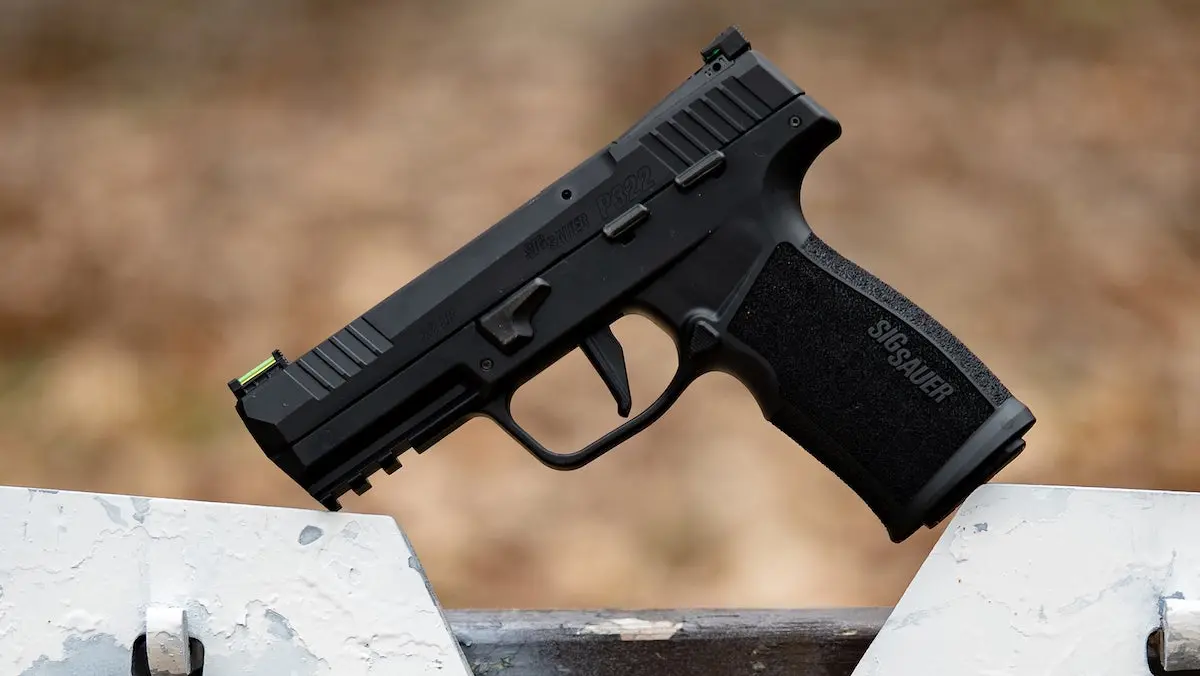
Specs
Price: $400
Chambering: 22 Long Rifle
Barrel length: 4 inches
Weight: 17.1 ounces
Trigger: 3 pounds
Capacity: 20 + 1
Pros
Affordable and fun to shoot
Smartly designed
Cons
Magazines were tedious to load
There are a lot of things to like about this pistol. It has an amazing 20+1 round capacity, it’s optic- and suppressor-ready, the trigger is interchangeable from curved to flat, it has fiber optic sights, ambidextrous controls, and a reversible magazine catch. And even though we ran it against guns with optical sights, it delivered the second-best precision on target. The only issue we had with the P322 was with its magazines. If when loading the magazines, you do not take care to stack rounds consistently, a round can pop out of the magazine as the pistol cycles, jamming the gun. If you do your job and load them right, this gun runs like a racecar regardless the ammo you’re using.
The pistol’s 20-round capacity is nice, especially for plinking, and everyone agreed it was the most fun gun to shoot. The factory sights were dead-on out of the box, and it shot well enough for precision plinking or small game hunting. It also received the best score with regard to shooter interface. The ambidextrous manual thumb safety adds a bit of peace of mind and the pistol is fantastically simple to field strip. At only 17.1 ounces, the P322 was also the lightest of all the handguns we tested. Had we outfitted the P322 with a reflex sight it would have likely earned the spot as the best pistol in our test. Still, half the test participants felt the P322 was the best gun. But we stuck to our scores; it came in 1.15 points behind the Taurus.
Browning Buckmark Vision Americana
(Score: 83.42)
Browning Buckmark Vision Americana
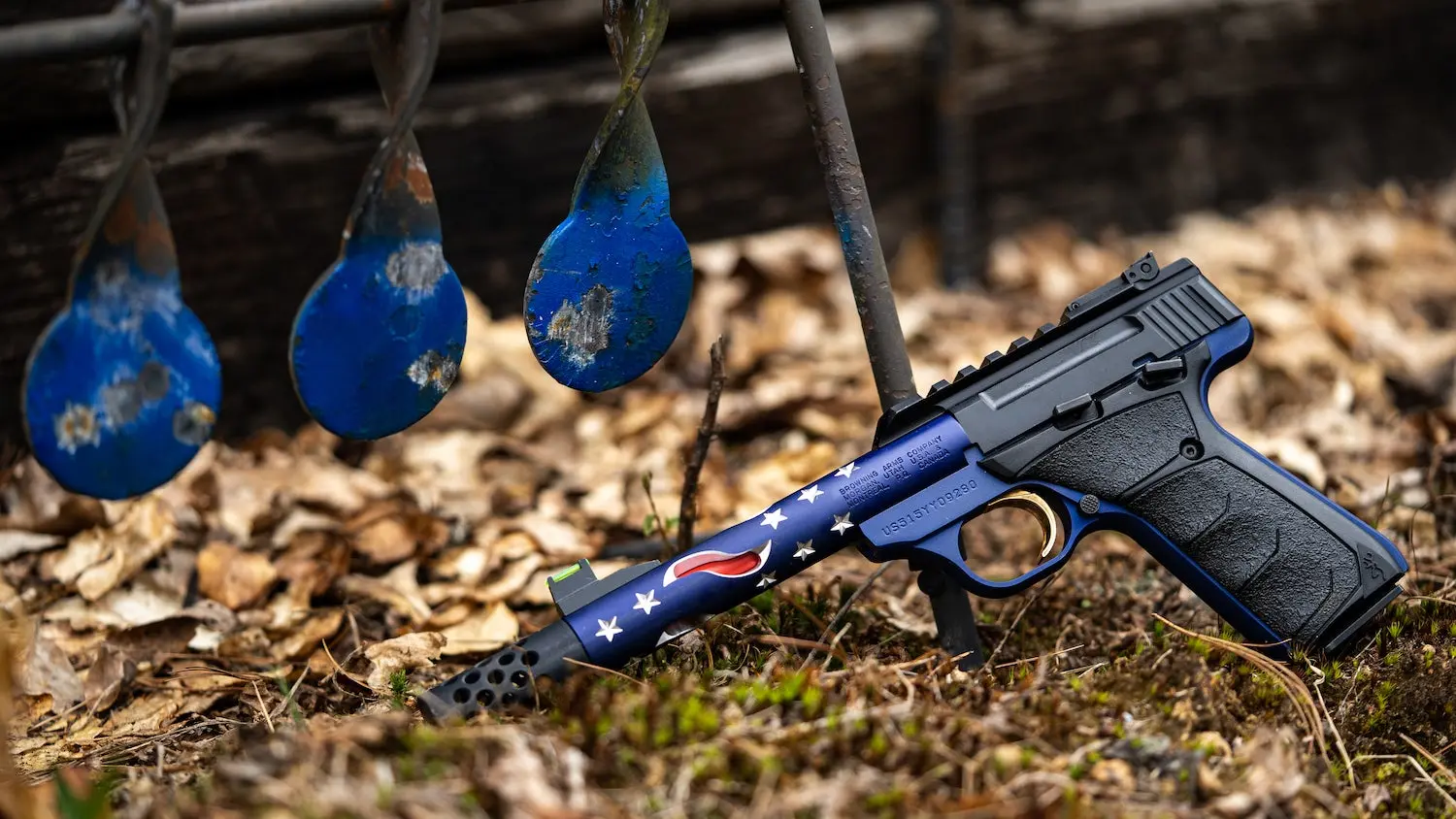
Specs
Price: $799.99
Barrel length: 5.875 inches
Weight: 27 ounces
Trigger: 4 pounds
Capacity: 10 + 1
Pros
Attractive and well made
Optics compatible
Cons
Expensive
The Browning Buckmark has been a popular .22 handgun for hunters and outdoorsmen since 1985. The new-for-2022 Buckmark is the Buckmark Plus Vision Americana Suppressor-Ready, and it’s distinguished by the blue barrel shroud with white stars and cutouts that reveal the red barrel. It’s outfitted with an adjustable rear sight and a fiber optic front sight. The muzzle is threaded, and the gun comes with a muzzle brake. There’s also a six-slot top rail for mounting a reflex sight or handgun scope, and it has a magazine disconnect—meaning that it will not fire without a magazine inserted.
From the bench, this handgun was the third most accurate in our test, and an optical sight would have likely improved on-target performance. It also ranked the highest in terms of quality of construction. However, the first pistol Browning supplied had some reliability issues that were uncharacteristic for this traditionally extremely reliable platform. Browning provided another, and it worked perfectly. Given this hiccup and the fact that this was the most expensive rimfire handgun we tested, we adjusted the score accordingly. If the price of admission doesn’t bother you, this latest version of the Buckmark is a very attractive pistol.
Ruger Wrangler Birdshead
(Score: 82.99)
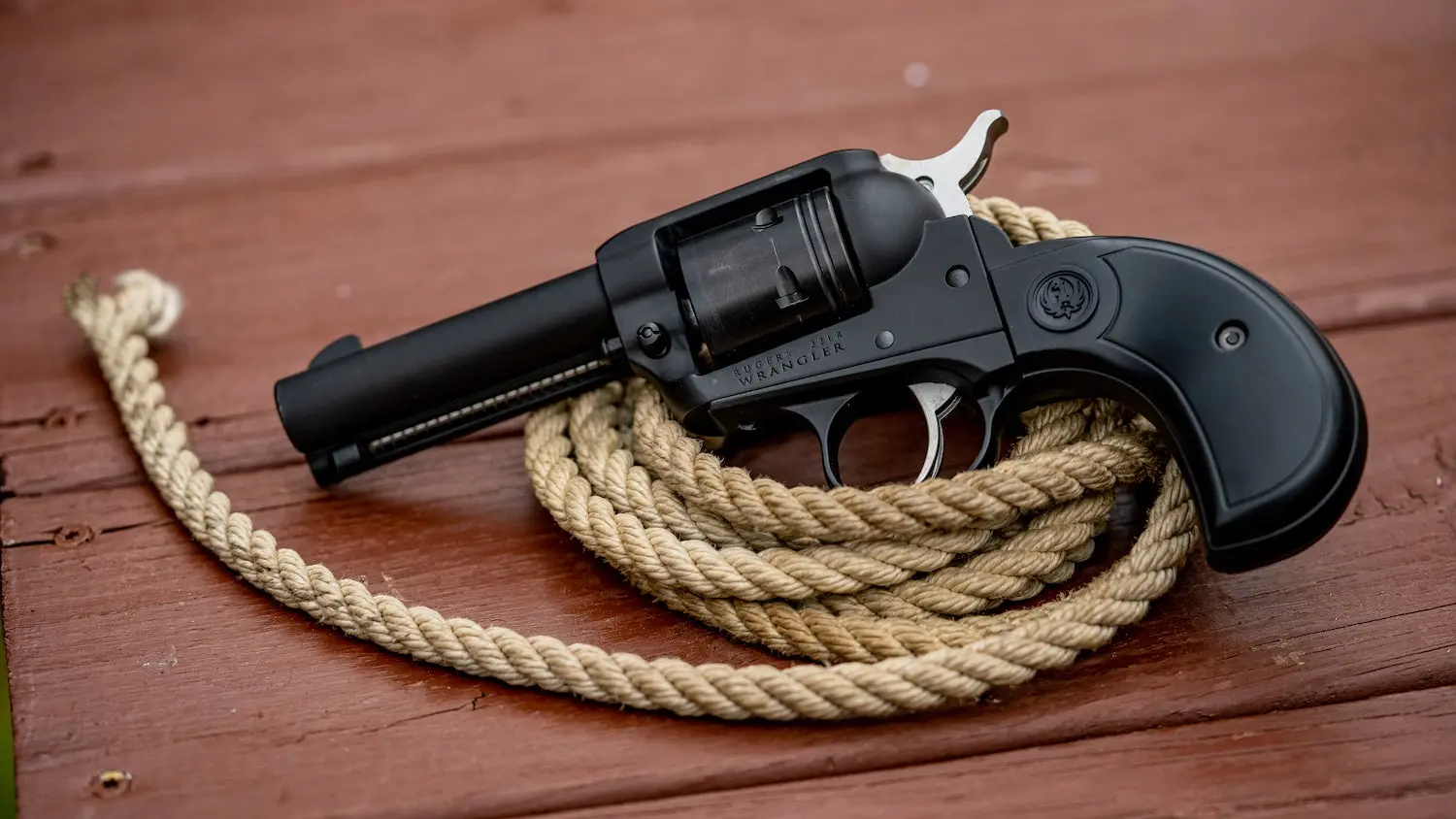
Specs
Price: $269
Barrel length:
Weight: 28 ounces
Trigger: 4.0 pounds
Capacity: 6
Pros
True Old West flare
Flawless operation
Cons
Rudimentary sights
The Wrangler is Ruger’s entry-level introduction to their more expensive Single Six rimfire revolver line. New for 2022 is this version with a birdshead grip. Our testers ranked the Ruger third in quality of construction behind the Sig P322 and the Browning Buckmark, but well ahead of the other revolvers in the test. We had no issues of any kind with this revolver, and it shot well, even though the sights are fixed and rudimentary. This gun was very compact and would wear well on a hip holster while hunting, hiking, or working on the farm. We tested the black version, but silver and bronze Cerakote editions are also available.
When compared to the other handguns in the test, the sights on the Wrangler were limiting. But the action was smooth and when the loading gate is thumbed open, the cylinder freewheels in both directions. This makes loading and unloading much easier. The Wrangler is a fantastic little .22 revovler, and while there’s nothing tactical about it, it should touch your inner cowboy better than any of the guns we tested.
Diamondback Sidekick
(Score: 70.10)
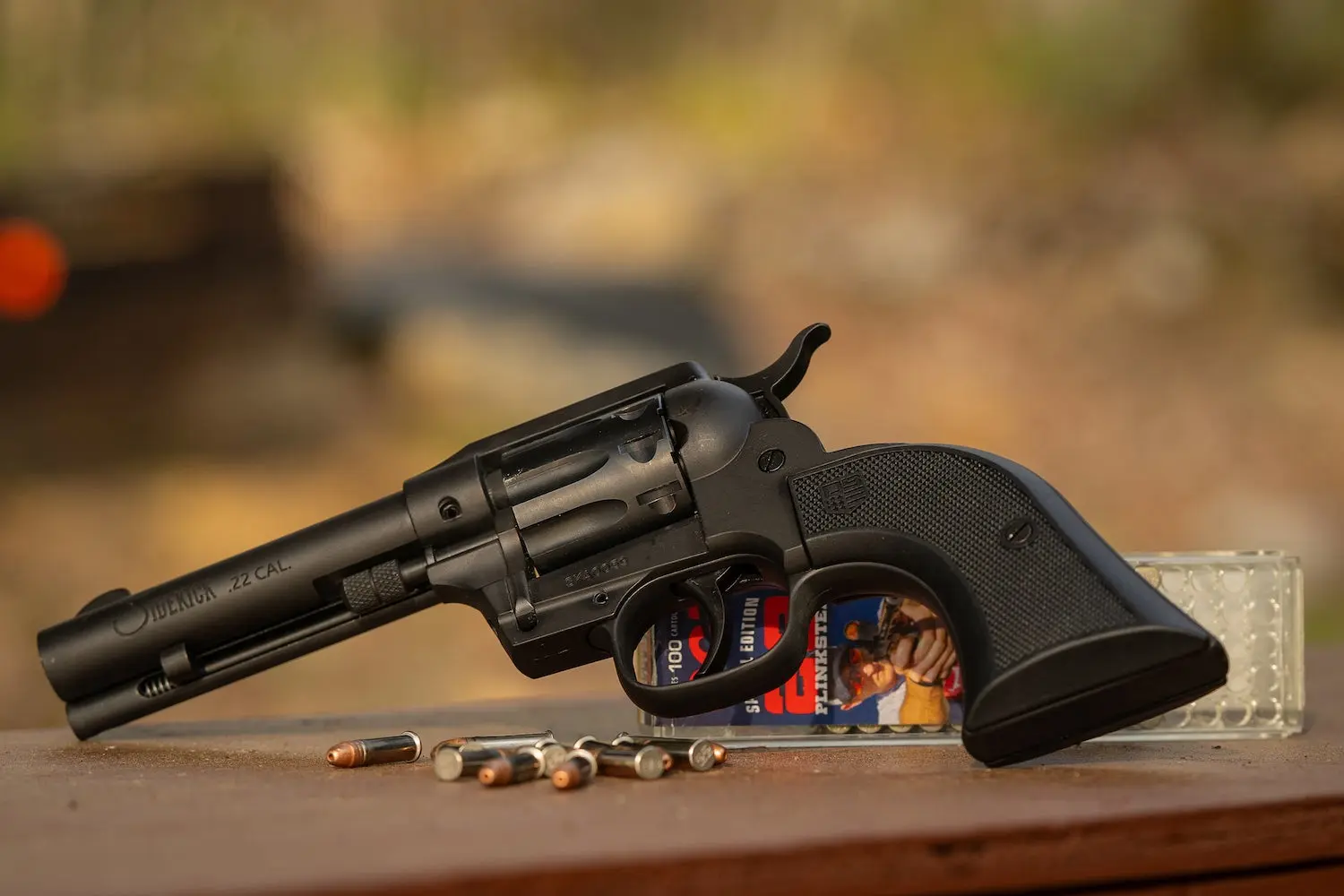
Specs
Price: $320
Barrel length: 4.5 inches
Weight: 32.5 ounces
Trigger: 2.0 pounds (single-action) 10.0 pounds+ (double-action)
Capacity: 9
Pros
Innovative design
Supplied with .22 Mangum cylinder
Cons
Rough operation
Sights are not adjustable and not zeroed
This little rimfire revolver brings with it a mix of good and bad news. It is unique in that while it looks like a single-action revolver, it’s actually a double-action. Also, while you would expect a gun that looks like cowboy revolver to load and unload through a loading gate, the cylinder on the Sidekick swings out of the frame. On top of all that, it comes with a separate cylinder for .22 Magnum, has a 9-shot capacity, and with the counterbored cylinders, it can be dry fired without worry of damage. Other than the reasonable price of $320, that’s all the good news we have.
On the bad side, the fixed sights were not regulated; there was a several-inch difference in point of aim and point of impact. Because of this, the gun gave us fits during the practical drills, which for sure negatively affected its score. The front sight could be filed to raise the point of impact, but most expect more from a new handgun. We also had some issues with the double-action trigger; it wanted to bind up on occasion. With its Western appearance, single/double action, and swing-out cylinder, it has a lot going for it—and we all really wanted it to perform better than it did—but it struggled to satisfy.
Best Handguns: Final Thoughts
Best Overall (Centerfire): Wilson Combat SFX9
Best Value (Centerfire): Taurus GX4
Best Revolver (Centerfire): Korth 2.75-inch Carry Special
Best for Outdoorsmen: Colt Python 3-inch
Best Overall (Rimfire): Taurus TX22 Competition SCR
Best Value (Rimfire): Heritage 6.5” Rough Rider Black Tactical Cowboy
Most Fun to Shoot: Sig Sauer P322
Of all the best handguns we tested above, we liked the Wilson Combat SFX9 as a standout. It’s well-made with an excellent trigger and even better sights, and it just feels good in your hand.
Why Trust Us
For more than 125 years, Field & Stream has been providing readers with honest and authentic coverage of outdoor gear. Our writers and editors eat, sleep, and breathe the outdoors, and that passion comes through in our product reviews. You can count on F&S to keep you up to date on the best new gear. And when we write about a product—whether it’s a bass lure or a backpack—we cover the good and the bad, so you know exactly what to expect before you decide to make a purchase.
![Field & Stream [dev]](https://images.ctfassets.net/fbkgl98xrr9f/1GnddAVcyeew2hQvUmrFpw/e4ca91baa53a1ecd66f76b1ef472932b/mob-logo.svg)





